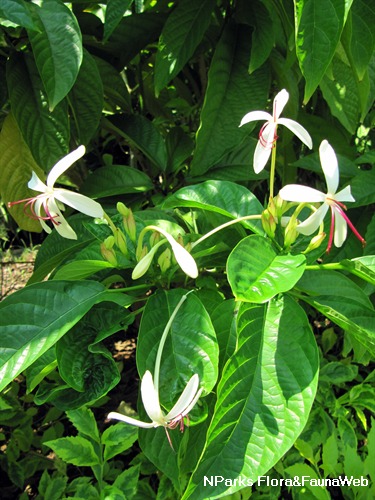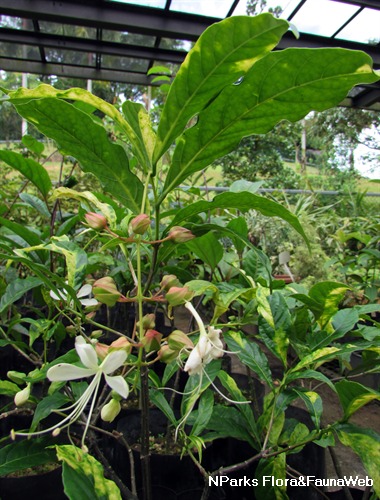
Name
Classifications and Characteristics
| Plant Division | Angiosperms (Flowering Seed Plants) |
|---|---|
| Plant Growth Form | Shrub |
| Mode of Nutrition | Autotrophic |
Biogeography
| Native Distribution | China, northern India, Vietnam |
|---|---|
| Native Habitat | Terrestrial |
| Preferred Climate Zone | Tropical |
| Local Conservation Status | Non-native |
Description and Ethnobotany
| Growth Form | Shrub that spreads by suckers, able to grow up to 1 m tall. |
|---|---|
| Foliage | Oval to ovate-shaped leaves, opposite arrangement, measuring about 20 - 30 cm long, margins are toothed, dark green on the top and light green underneath. |
| Flowers | Pink fragrant flowers borne in an inflorescence, each flower measuring about 1 - 2 cm wide. |
| Etymology | Genus epithet Clerodendrum is from the Greek word "kleros" which means chance and "dendron" meaning a tree. Species epithet bungei is named after A. von Bunge (1813 - 1866) who was a herbalist in Ukraine. |
Landscaping Features
| Desirable Plant Features | Ornamental Flowers |
|---|---|
| Landscape Uses | Parks & Gardens, Small Gardens |
Fauna, Pollination and Dispersal
| Fauna Pollination Dispersal Associated Fauna | Butterfly-Attracting |
|---|
Plant Care and Propagation
| Light Preference | Full Sun |
|---|---|
| Water Preference | Lots of Water, Moderate Water |
| Plant Growth Rate | Moderate |
| Rootzone Tolerance | Moist Soils, Well-Drained Soils |
| Propagation Method | Stem Cutting |
Foliar
| Mature Foliage Colour(s) | Green |
|---|---|
| Foliar Arrangement Along Stem | Opposite |
| Foliar Margin | Serrate / Toothed |
| Leaf Area Index (LAI) for Green Plot Ratio | 4.5 (Shrub & Groundcover - Dicot) |
Floral (Angiosperm)
| Flower & Plant Sexuality | Bisexual Flowers |
| Flower Colour(s) | Pink |
|---|---|
| Flower Grouping | Cluster / Inflorescence |
Image Repository
Others
| Master ID | 522 |
|---|---|
| Species ID | 1818 |
| Flora Disclaimer | The information in this website has been compiled from reliable sources, such as reference works on medicinal plants. It is not a substitute for medical advice or treatment and NParks does not purport to provide any medical advice. Readers should always consult his/her physician before using or consuming a plant for medicinal purposes. |







.jpg)
